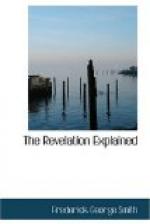To this star was given a key. In the Gospels the same figure is employed, where the ministers of Christ are represented as possessing the keys of the kingdom of heaven, showing that they acted in his name and by his authority. How appropriate, then, is this symbol as applied to a false teacher, who possesses, not the keys of the kingdom of heaven, but, instead, “the key of the bottomless pit”! Thus, under the symbol of the star and the key, we have the teacher and his authority set forth. Armed with this authority, this false teacher “opened the bottomless pit; and there rose a smoke out of the pit, as the smoke of a great furnace; and the sun and air were darkened by reason of the smoke of the pit.” In the Scriptures Jesus is represented as the Sun of righteousness, while “the light of the glorious gospel of Christ” illuminates the world. But here we have something of the opposite character—a dense smoke eclipsing the sun and darkening the heavens. Have we not here a fit representation of a delusive faith proceeding from its true source, “the bottomless pit”? And is not a fallen star an appropriate symbol of its propagator?
In representing a system of religion by these objects from nature we depart from the general rule first laid down—that objects of nature symbolize political affairs, while the department of human and angelic life is chosen to represent religious affairs. But the reader should bear in mind one important exception to this rule—that things prominently connected with the history of the people of God in former ages are frequently employed (regardless of the department to which they belong) to represent spiritual things, their interpretation being easily seen; such as candle-sticks, altar, temple, incense, etc. When the plague of “thick darkness” covered the land of Egypt for three days, “the children of Israel had light in their dwellings.” In the exodus the Lord went before them “by night in a pillar of fire, to give them light.” After the erection of the tabernacle the holy place was constantly illuminated. This natural light in the Jewish age constitutes a beautiful type of the spiritual “light of the glorious gospel of Christ” that has “shined in our hearts” in the Christian dispensation. This spiritual light comes from Christ, the “Sun of righteousness,” the “true Light which lighteth every man that cometh into the world”; and proceeds, also, from his people, who “shine as lights in the world.” But it is the “light of the gospel.” This light proceeds in a special sense from God’s ministers, who are represented as “stars” (chap. 1:20) and who possess “the keys of the kingdom of heaven.” Mat. 16:19; 18:18. How appropriate, then, that a fallen “star,” possessing “the key of the bottomless pit,” should be a symbol of a religious impostor, and that the smoke which darkened the heavens, eclipsing the sun, the source of light, should represent a prominent delusive faith!




